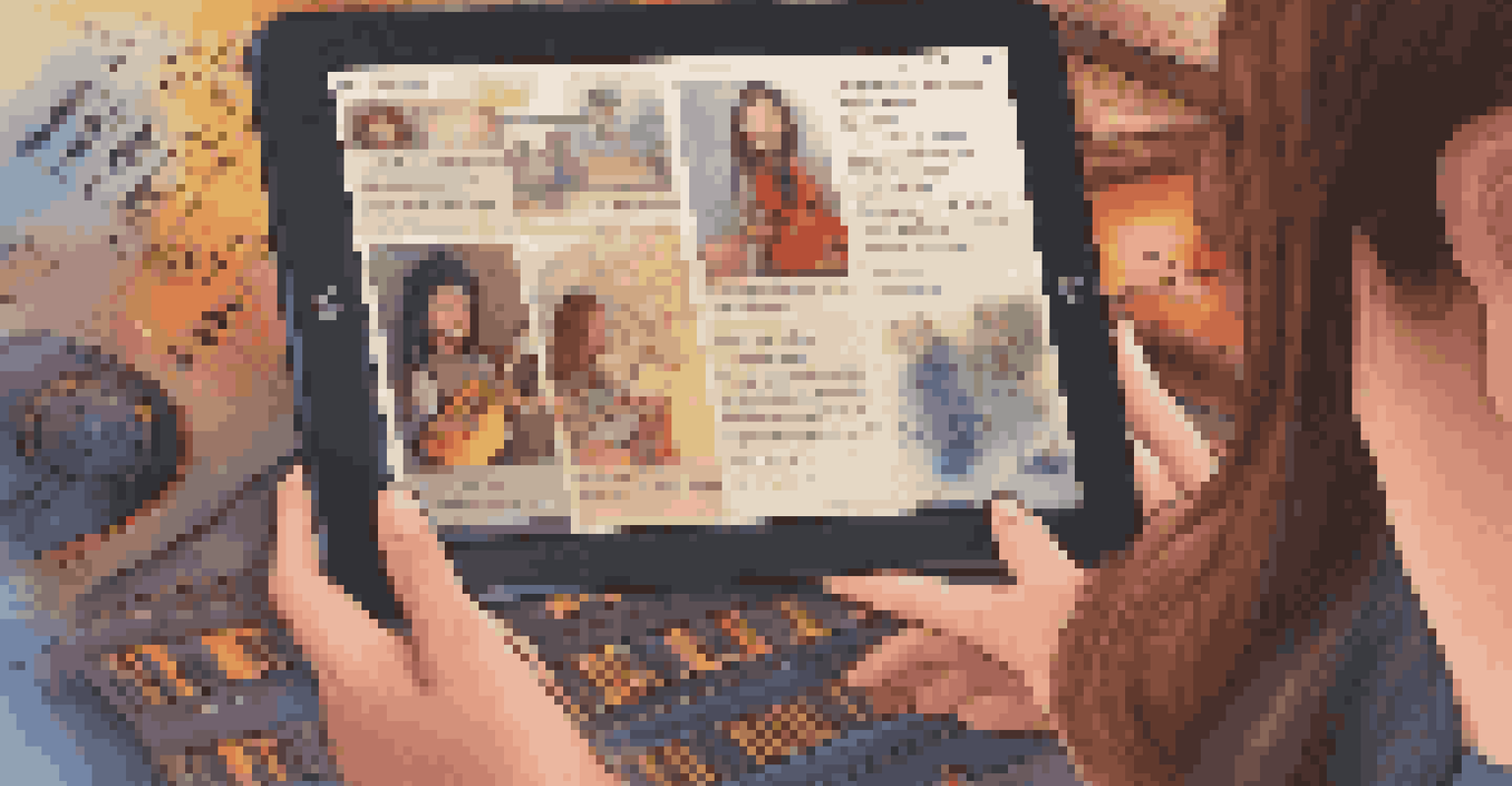Using Music as a Bridge for Cultural Understanding in Education

The Power of Music in Bridging Cultures
Music is a universal language that transcends borders and connects people. It has the unique ability to convey emotions and ideas that words sometimes cannot express. Through melodies and rhythms, individuals from diverse backgrounds can share their stories and experiences, creating a shared understanding.
Music can change the world because it can change people.
When students engage with music from various cultures, they open themselves to new perspectives and experiences. This exposure helps to break down stereotypes and fosters empathy, allowing students to appreciate the rich tapestry of human expression. Music serves as a powerful tool for cultural exchange, encouraging curiosity and dialogue.
By integrating music into educational settings, educators can create an inclusive environment where students feel valued and understood. Incorporating songs and traditions from different cultures not only enriches the curriculum but also enhances students' overall learning experience, making it more engaging and relatable.
Music as a Tool for Social Emotional Learning
Engaging with music can significantly enhance social-emotional learning (SEL) in the classroom. Through music, students can explore their own emotions and learn to express themselves in a constructive manner. This journey toward self-awareness is critical for building strong interpersonal relationships.

When students listen to or perform music from various cultures, they often find common ground with their peers. This shared experience fosters a sense of belonging and community, crucial elements for emotional development. Music encourages collaboration, as students often work together to create or interpret songs, strengthening their bonds.
Music Unites Diverse Cultures
Engaging with music from various cultures fosters empathy and understanding, breaking down stereotypes among students.
Moreover, music can be an effective way to address difficult subjects related to identity and diversity. By discussing the themes in songs from different cultures, educators can facilitate conversations about empathy, respect, and understanding, laying the groundwork for a more inclusive and supportive classroom environment.
Integrating Music into the Curriculum
Integrating music into various subjects can enhance the learning experience and deepen cultural understanding. For instance, teachers can incorporate songs from different cultures into history lessons, allowing students to explore the historical context behind the music. This approach not only makes learning more dynamic but also emphasizes the interconnectedness of culture and history.
Without music, life would be a mistake.
In language arts, analyzing the lyrics of songs can help students develop critical thinking skills while also expanding their vocabulary and comprehension. By discussing the meanings and emotions behind the words, students gain insight into the cultural significance of the music, building a deeper appreciation for diversity.
Furthermore, music can be used in science and math classes to teach concepts like rhythm, patterns, and sound waves. This interdisciplinary approach not only engages students but also highlights the role of music in various fields, showcasing its relevance and importance in everyday life.
Collaborative Music Projects in Schools
Collaborative music projects offer students a hands-on opportunity to engage with different cultures. By forming bands or choirs that include music from various backgrounds, students can experience the joy of making music together while learning about each other’s traditions. These projects encourage teamwork and communication, vital skills for future success.
Such initiatives can take many forms, from cultural fairs featuring performances to songwriting workshops that invite students to create music inspired by their heritage. These activities not only celebrate diversity but also foster a sense of pride and ownership among students for their cultural backgrounds.
Music Enhances Emotional Learning
Incorporating music in education supports social-emotional learning by helping students explore and express their emotions.
Moreover, these collaborative experiences can extend beyond the classroom. Schools can partner with local cultural organizations or musicians to bring authentic experiences to students, enriching their understanding and appreciation of the music and cultures represented within their community.
The Role of Technology in Music Education
In today’s digital age, technology plays a crucial role in music education, making it easier than ever to access a diverse range of musical styles. Online platforms allow students to explore music from around the world, breaking down geographical barriers and fostering cultural appreciation. This instant access helps to create a more global classroom experience.
Additionally, technology facilitates collaboration among students from different backgrounds. Tools like video conferencing and online music platforms enable students to connect and create music together, regardless of their physical location. This virtual collaboration not only enriches their learning but also nurtures friendships that transcend cultural differences.
Furthermore, technology can assist educators in delivering more engaging lessons. Interactive apps and software provide students with opportunities to experiment with music creation, allowing them to incorporate their cultural influences into their work. This hands-on approach empowers students to express their identities through music, reinforcing the idea that every voice matters.
Challenges and Considerations in Music Education
While music can be a powerful tool for cultural understanding, there are challenges to consider in its implementation within education. One significant hurdle is the potential for cultural appropriation, where elements of one culture are borrowed without proper understanding or respect. Educators must approach music education with sensitivity and a commitment to teaching the historical and cultural context of the music.
Moreover, access to diverse music resources can be limited in some areas, making it challenging for educators to provide a well-rounded musical experience. Schools may need to seek partnerships with local cultural organizations or utilize online resources to ensure a rich variety of music is available for their students.
Technology Boosts Music Education
Modern technology expands access to diverse musical styles, facilitating collaboration and enriching the learning experience.
Lastly, not all students may initially engage with music from cultures different from their own. Educators should be prepared to address resistance by fostering open discussions and creating a safe environment where students can express their feelings and experiences. By doing so, they can help students appreciate the value of diversity and the role of music in promoting cultural understanding.
The Future of Music and Cultural Understanding in Education
As we look to the future, music will continue to play a vital role in fostering cultural understanding in education. With the increasing globalization of societies, the need for empathy and cross-cultural communication skills is more important than ever. Schools have the opportunity to be at the forefront of this movement by integrating music education into their curricula.
Innovative teaching methods that incorporate technology and collaborative projects will further enhance students’ understanding of diverse cultures. By embracing these approaches, educators can create more dynamic and inclusive learning environments that celebrate diversity and encourage mutual respect.

Ultimately, the goal is to equip students with the tools they need to navigate an interconnected world. By using music as a bridge for cultural understanding, educators can help nurture a generation that values diversity, practices empathy, and is prepared to engage thoughtfully with people from all walks of life.